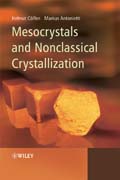
Mesocrystals: New Self-Assembled Structures provides an introduction to self assembly, classical crystallization, colloidal crystals and mesocrystals. It describes the concept of mesocrystals and their properties and gives examples of mesocrystal systems. This is followed by an exploration of the mechanism of mesocrystal formation and the tuning of their properties. Finally, the future potential of mesocrystals is outlined. INDICE: Contents Preface 1. Introduction 2. Physico-Chemical Principles ofCrystallization 2.1 Classical Crystallization 2.2 Definition of a Crystal andCrystal Growth 2.3 Nucleation Theories 2.4 Some Points towards a More Realistic View of Supersaturation And Crystallization 2.5 Thermodynamic and Kinetic Crystallization Pathways 2.6 Polymorph Control 2.7 Crystal Morphology and the Role of Additives and Selective Absorption 2.8 Properties of Single Crystals and Polycrystals 3. Examples of Crystals Challenging The Classical Textbook Mechanism 3.1 Some Biomineral Examples 3.2 From Biology to Biometrics: In Vitro Mineralization Examples 3.3 Biomorphs 3.4 Other Synthetic Examples 4. Non-Classical Crystallization 4.1 Amorphous Precursors 4.2 Liquid Precursors 4.3 Oriented Attachment 5. Self Assembly and Self Organization 6. Collodial Crystals withSpherical Units: Opals and Collodial Nanocrystals 7. Mesocrystal Systems 7.1 Mesocrystals and Their Properties 7.2 Early Reports on Mesocrystals 7.3 One-Dimensional Mesocrystals 7.4 Two-Dimensional Mesocrystals 7.5 Mesocrystals in Biomineralization 7.6 Mesocrystals in Gels 7.7 Mesocrystals Formed without Additives 7.8 Mesocrystals Formed with Simple Ion Additives 7.9 Mesocrystals Formedwith Polymer Additives 7.10 Mesocrystals in Non-Aqueous Systems 7.11 Mesocrystals Formed via Solid-State Reactions 7.12 Liquid Crystals, Tactoids, Somatoids, and Schiller Layers 8. Mechanisms of Mesocrystal Formation 8.1 Principle Mechanisms Leading to Mesocrystals 8.2. Conditions for Mesocrystal Formation 8.3Alignment by Colloidal Forces, Capillarity And Other Short-Ranged Physical Fields 8.4 The Role of Magnetic Fields 8.5 The Role Of Dipole and Polarization Forces 8.6 The Role of External Electric Fields 8.7 Self Similar Assembly and Shape Constraints 8.8 Shaping of Mesocrystals 8.9 Mesocrystals as Intermediatesin Single Crystal Formation 9. Analysis of Mesocrystals 10. Tuning of Properties 11. A Unifying Crystallization Mechanism 12. Analogy between Oriented Attachment or Heirarchically Structured Crystals and Polymers 12.1 Analogy betweenOriented Attachment and Polymerization 12.2 Structural Levels in Hierarchically Structured Crystals and Biopolymers 13. Summary and Outlook References Listof Abbreviations, Definitions
- ISBN: 978-0-470-02981-7
- Editorial: John Wiley & Sons
- Encuadernacion: Cartoné
- Páginas: 288
- Fecha Publicación: 06/06/2008
- Nº Volúmenes: 1
- Idioma: Inglés
